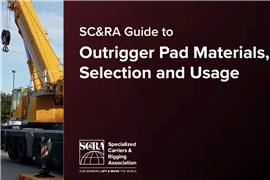Used or abused?
24 April 2008

The risk associated with buying used equipment results from not knowing how it was used and what level of care it has (or hasn’t) received. However, there are ways to compensate for this lack of information.
The easiest is to know the seller, a point made by many of AI’s sources for this article. “Buying from a reputable seller is the most important thing,” says John Ball, managing director of Height for Hire in Dublin, Ireland, which sells its platforms directly after two or three years. Glyn Goodwin, Genie’s recently appointed used equipment sales manager for Europe, adds that buying from a seller you know is also important if you want continued after sales service on the unit.
Mr Goodwin makes another commonly expressed point: “Look for a traceable history of the equipment. In Europe, buy equipment with a CE mark and make sure the machine has the certificates to show that it complies with regulations.”
The dangers in ignoring that advice are demonstrated by one example given by Alan McIntyre, engineering product support manager in the UK for JLG Industries. He tells AI of one recent buyer who bought two JLG machines of the same model at the same auction; the new owner learned that one was CE compliant and the other was not.“There was nothing anyone, not even us, could do, and the one machine was essentially a pile of junk for him,” says Mr McIntyre.
Enough information?
However, some purchase opportunities do not provide as much information as buyers might want. “Auctions provide a range of equipment for purchase, and buyers make their choice. All they can see is the machine,“ says Cedric Jandet, marketing manager, Europe for Ritchie Bros, the international auction company based in Vancouver, Canada. (Ritchie Bros does ensure clear title and provides any available certificates and all seller-provided information for every machine it auctions, says Mr Jandet.)
Whatever the level of risk, then, what might an astute buyer try ‘to see’ in a used machine? Rick Moyer, owner of Construction Reach Management, a used equipment brokerage company in Fresno, California, uses a few condition indicators to determine if he needs to look more closely.
Mr Moyer tells AI that tyre condition could signal that the machine has been driven over and into damaging objects. Damage to control cables, upper boom sections, platforms, and upper control boxes are further indications that “somebody hasn’t been paying attention to things.”
Another item receiving his scrutiny is the battery box - looking particularly for corrosion and dirt. “If it is not taken care of, what else is not?”, he says. Also, accumulated dirt and over spray paint on the machine mean possible contamination of motors and controls.
A buyer should also consider, according to Mr Ball, a machine’s age, which anyone can reliably determine (see box story). If it is five years or more, be cautious, he suggests, adding that a five-year-old machine should have only about 2500 hours on its hours counter.
Far less quantifiable is the matter of paint. “A lick of paint is a fantastic thing,“ one industry source told AI. The observation contains both irony and a message: a coat of paint can cover defects, but it also seems an easy way to create a positive first impression.
p>Mr Moyer says buyers tell him that if two machines are otherwise the same, they do not care about paint condition. “However,” he continues,“99% of the time, the buyer will go to the one with new paint.” Mr Moyer will paint machines if the seller requests, or if he himself thinks doing so will raise the price.Mr Jandet of Ritchie Brothers says the opportunity to raise the price with a new paint job depends on “...what machine you’re talking about. You need to see the value in the machine. If it’s in good shape, paint can increase the sales price.”
Mr Moyer in Fresno raises a note of caution about buying a machine that has been painted for sale.“If a machine has been painted for auction, it will have been done as cheaply as possible, “ he says. His experience is that sandblasting, a common preparation as part of a cheap paint job, can put sand in hydraulics. Some painters sandblast in order to skip putting on a primer coat. Doing so exposes bare metal when the coat of cheap paint comes off, which is often soon.
Colour choice
If you do decide to paint, Mr Goodwin of Genie suggests you choose the colour carefully,“Machines in manufacturers’ colours retain a better value than those painted in custom colours for customers.” Another consideration about painting, as Mr Jandet points out, is that it is difficult to paint well the fibreglass covers found on some machines (although there are some substances, such as that marketed by Dakota Shine, that can help here too).
Looking good is one thing, getting the job is another. Equipment functionality is worthy of evaluation, too. Philippe Parmentier, who is responsible for access equipment for TVH, the Belgium-based used equipment dealer, emphasises the need to,“...make sure they are in normal working order.” Complementing that is advice from Mr Ball, “Bring [to assess the machine] someone who knows what they’re looking for. I’ve seen buyers send people who might know how to negotiate, but they don’t know much about equipment.”
Your assessment effort can depend on how many items you’re buying. Willem Hilderink, owner of used equipment broker Accessbusiness in The Netherlands, notes that the condition of equipment in lots will be mixed. “The risks across the lot will be built into the price for the lot as a whole.” Mr Hilderink suggests you be prepared to deal with the machines that will be below the average.
If you are in the market for just one machine, or it is an expensive item, more care to evaluate condition might be warranted. Mr Moyer encourages disinterested, third party inspection. It is “cheap insurance” at US$100 to 200 for a mechanic to check out the machine, he says. He also advocates using digital pictures and video. “The more the better; they’re good for sharing information about machine condition,” he says, “and photograph any problems, too.”
Exchange of information might precede a sale, but the sale itself is definitely an exchange of value. As such, it is an opportunity to maximize value. What can sellers do to make equipment more attractive in the marketplace and, the flip side of that coin, what might a buyer consider cost justifiable?
In addition to considering a new paint job, Mr Moyer’s advice for preparing for sale corroborates the first point of this article - take care of your equipment well. He says owners should maintain batteries properly and not leave water standing in battery boxes. Regular, thorough cleaning of the machine is important, too, but he cautions about the possible damage from overly zealous steam cleaning.
When it is time to sell, he advises sellers to ensure their equipment is in good operating condition and removing all proprietary decals and other markings of their companies, in order to reduce litigation risk.
So, while being in the secondhand access equipment market - as either a buyer or a seller - involves certain risks, there are steps you should consider taking. Smart access equipment owners will act to get their money’s worth - whichever side of the transaction they're on


